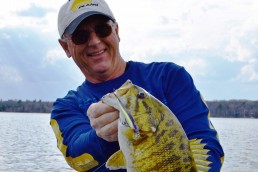Crawl-and-drawl for Sluggish Bass
SHARE THIS POST
Trust me: sluggish bass, walleyes and panfish hunkered tight to the bottom in less-than-ideal conditions are suckers for a jig crawling along the bottom with frequent stops. I like to call this the “crawl-and-drawl.”
Admittedly, crawling jigs along the bottom with frequent stops is nothing new. Anglers have been dragging and crawling various small plastics, hair jigs and live bait rigs for all sorts of freshwater and saltwater gamefish for decades.
One of the best benefits of a crawl-and-drawl tactic is that it affords you some creative freedom. Feel free to really shake and jiggle the bait in place. Or, you can simply let it rest motionlessly next to the cover in which big fish hide. Sometimes it’s a lack of movement that will garner a fish’s attention.
My own experience catching bass with the crawl-and-drawl, dates all the way back to the late 1960s. Then, I’d focus primarily on trying to trigger sluggish largemouth bass with Texas-rigged straight-tailed worms. I discovered that cover-tight bass in cold fronts were most catchable when a cast was made right into thick cover followed by a prolonged pause (drawl), and then a short crawl before repeating the drawl. Most bass anglers still tend to gravitate to this tactic whenever fish get tough to catch.
First and foremost, I’d recommend splurging on some nicer stand-up jigs; a quality stand-up jig with a good hook and a brush guard is paramount to success with this technique. What you rig on that jig can also make a difference for sure, but a reliable jig comes first. A poorly manufactured jig is bound to tip over at rest, leaving it sitting ineffectively at the bottom. Worse, it may snag bottom debris and rock crevices. A decent stand-up jig keeps the hook upright and ready to hook while presenting the bait in an active, lifelike manner.
Are you enjoying this post?
You can be among the first to get the latest info on where to go, what to use and how to use it!
What you slip onto the hook and collar of a jig for the crawl-and-drawl technique can vary greatly, but I tend to reach for straight-tailed worms and crawfish imitation plastics first. Although, any curly-tailed grub or paddle-tail design can also work well. The key is to choose a combo that works well together. Drop it over the side of the boat in shallow water and watch it work as you drag it along the bottom. Also, does it remain upright at rest? Generally speaking, if it looks good and performs correctly, it is bound to catch fish with the crawl-and-drawl tactic.
Some of my biggest bass and walleyes have fallen for the crawl-and-drawl technique over the course of my fishing career. Since that time, improvements in the original stand-up jig design have occurred. For instance, weedless hook guards enable one to fish this deadly jig tighter to cover. Hook manufacturing technology has evolved substantially, too. Today’s premium jig hooks sport ultra sharp thin wire that won’t bend out like older thin wire hooks did.
As far as baiting the hooks is concerned, I’ve found success with just about everything a smart angler might pair with the stand-up jig. But my most exciting recent find was that I’m able to work hollow tubes off the jig. Most bass anglers, particularly those who chase smallies, know how productive a hollow tube lure can be on these critters. There’s a risk involved, though: tubes present problems in jig rigging due to their hollow design. There simply isn’t much soft plastic to lock up around a jig collar and hold the tube in place. The solution? A drop of waterproof fisherman’s glue on the hook shaft near the base, where it joins the lead head. Then, simply slide the tube over the glue and push it up against the back end of the jighead for a few seconds, gluing the tube to the hook shaft and the back end of the jig base. This allows you to fish the deadly hollow tube in and around cover such as brush piles, weeds, man-made fish cribs and any other bass-friendly targets you might see.
No doubt, the crawl-and-drawl is a killer tactic for reluctant cold-water bass and other gamefish. Pick up a few quality stand-up jigs along with some premium plastics and give this a try when you run into tight-lipped lunkers.
MWO
SHARE THIS POST
Did you enjoy this post?
You can be among the first to get the latest info on where to go, what to use and how to use it!
Joe Bucher
Joe Bucher is a Freshwater Fishing Hall of Fame Legendary Angler, book author, lure designer and host of Fishing with Joe Bucher TV series.



